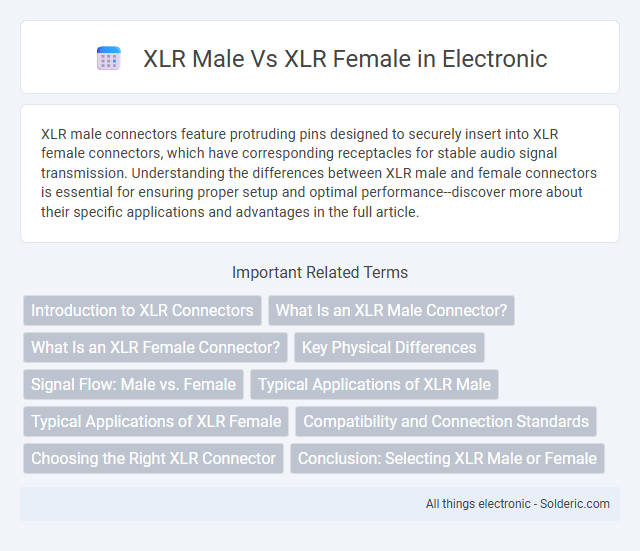XLR male connectors feature protruding pins designed to securely insert into XLR female connectors, which have corresponding receptacles for stable audio signal transmission. Understanding the differences between XLR male and female connectors is essential for ensuring proper setup and optimal performance--discover more about their specific applications and advantages in the full article.
Comparison Table
| Feature | XLR Male | XLR Female |
|---|---|---|
| Connector Type | Pin (Protruding Pins) | Socket (Receptacles) |
| Usage | Output connector (typically source) | Input connector (typically destination) |
| Number of Pins | 3 pins (standard), can vary | 3 pins (standard), can vary |
| Common Applications | Microphones, audio equipment outputs | Mixers, amplifiers, audio equipment inputs |
| Gender Purpose | Male connector plugs into female | Female connector receives male |
| Physical Design | Cylindrical body with three exposed pins | Cylindrical body with three recessed holes |
| Signal Type | Balanced audio signals | Balanced audio signals |
Introduction to XLR Connectors
XLR connectors, commonly used in professional audio and video equipment, feature distinct male and female types designed for specific functions. The XLR male connector typically has three pins that fit into the female connector's three corresponding holes, ensuring secure, balanced audio signal transmission. This robust design minimizes noise interference, making XLR cables ideal for microphones, mixers, and other audio devices requiring high-quality connective performance.
What Is an XLR Male Connector?
An XLR male connector features three pins designed to plug into an XLR female connector, commonly used in professional audio and video equipment for balanced audio signals. Its robust design ensures a secure connection, minimizing noise and interference in microphone and speaker setups. Understanding your XLR male connector helps maintain optimal audio quality in recording and live sound environments.
What Is an XLR Female Connector?
An XLR female connector features three holes designed to receive the corresponding pins of an XLR male connector, ensuring a secure and balanced audio connection. It is commonly used in professional audio equipment such as microphones, mixers, and amplifiers to provide reliable signal transfer with minimal interference. Understanding the role of an XLR female connector helps you make informed decisions when setting up or troubleshooting your audio system.
Key Physical Differences
XLR male connectors feature three pins protruding outward, designed to plug into female counterparts that have three corresponding holes or sockets. The key physical difference lies in the pin configuration: males have pins that transmit the audio signal, while females have sockets to receive it, ensuring proper alignment and secure connection. This gendered design prevents incorrect cable orientation and maintains signal integrity in audio equipment setups.
Signal Flow: Male vs. Female
XLR male connectors typically serve as the output source, sending the audio signal to the receiving end, while XLR female connectors function as the input, accepting the incoming signal. The signal flow moves from the male plug, which has three pins transmitting positive, negative, and ground signals, into the female socket that securely receives these pins to maintain balanced audio transfer. Proper matching of male outputs to female inputs ensures optimal signal integrity and reduces noise interference in professional audio setups.
Typical Applications of XLR Male
XLR male connectors are typically used as the output end in audio equipment, such as microphones, mixers, and audio interfaces, transmitting balanced audio signals. They connect to XLR female inputs on devices like amplifiers, speakers, and recording equipment to ensure secure signal transfer with minimal interference. Your setup relies on XLR male connectors to deliver professional-quality sound in live performances, broadcasting, and studio recording environments.
Typical Applications of XLR Female
XLR female connectors are commonly used in audio equipment to receive signals from microphones, mixers, or other audio sources, ensuring secure and balanced connections. Their typical applications include stage sound, recording studios, and live event setups where reliable signal transmission and noise reduction are essential. You rely on XLR female connectors to maintain high-quality audio input in professional and consumer audio systems.
Compatibility and Connection Standards
XLR male connectors feature three pins that align with three corresponding holes in XLR female connectors, ensuring secure and reliable audio signal transmission. Compatibility between XLR male and female connectors adheres to the IEC 61076-2-103 standard, which defines pin configuration and mechanical dimensions, enabling universal interchangeability across professional audio equipment. The locking mechanism on XLR connectors guarantees stable connections, preventing accidental disconnections during live performances or studio recordings.
Choosing the Right XLR Connector
Choosing the right XLR connector depends on your specific audio setup and device compatibility. XLR male connectors typically serve as outputs, sending balanced audio signals, while XLR female connectors are inputs designed to receive these signals. Ensuring your cables and equipment match with the correct male or female XLR connectors guarantees optimal sound quality and reliable connections for your professional audio needs.
Conclusion: Selecting XLR Male or Female
Selecting between XLR male and female connectors depends on your audio setup and signal flow requirements. XLR male connectors typically serve as output plugs on microphones or devices sending signals, while XLR female connectors are designed as inputs on mixers, amplifiers, or speakers. Understanding the proper use of male and female XLR connectors ensures secure connections, prevents signal interference, and maintains optimal audio performance for your equipment.
XLR male vs XLR female Infographic

 solderic.com
solderic.com